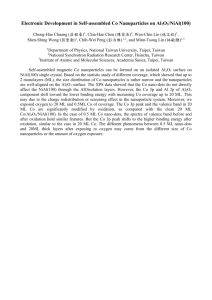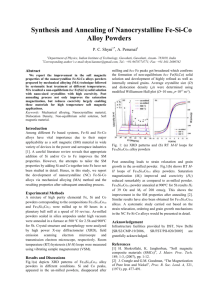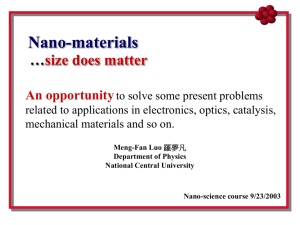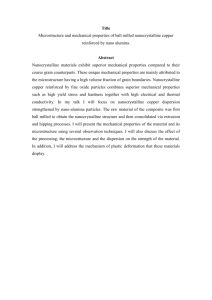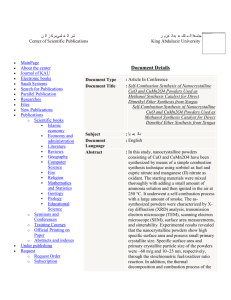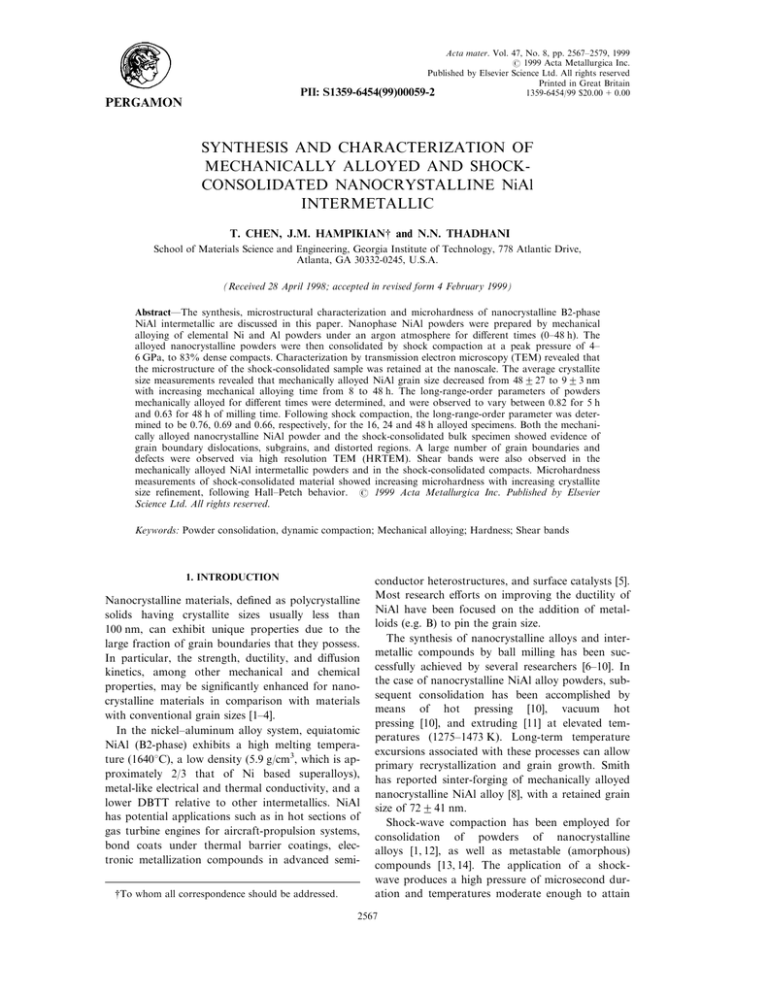
PII:
Acta mater. Vol. 47, No. 8, pp. 2567±2579, 1999
# 1999 Acta Metallurgica Inc.
Published by Elsevier Science Ltd. All rights reserved
Printed in Great Britain
S1359-6454(99)00059-2
1359-6454/99 $20.00 + 0.00
SYNTHESIS AND CHARACTERIZATION OF
MECHANICALLY ALLOYED AND SHOCKCONSOLIDATED NANOCRYSTALLINE NiAl
INTERMETALLIC
T. CHEN, J.M. HAMPIKIAN{ and N.N. THADHANI
School of Materials Science and Engineering, Georgia Institute of Technology, 778 Atlantic Drive,
Atlanta, GA 30332-0245, U.S.A.
(Received 28 April 1998; accepted in revised form 4 February 1999)
AbstractÐThe synthesis, microstructural characterization and microhardness of nanocrystalline B2-phase
NiAl intermetallic are discussed in this paper. Nanophase NiAl powders were prepared by mechanical
alloying of elemental Ni and Al powders under an argon atmosphere for dierent times (0±48 h). The
alloyed nanocrystalline powders were then consolidated by shock compaction at a peak pressure of 4±
6 GPa, to 83% dense compacts. Characterization by transmission electron microscopy (TEM) revealed that
the microstructure of the shock-consolidated sample was retained at the nanoscale. The average crystallite
size measurements revealed that mechanically alloyed NiAl grain size decreased from 48 227 to 923 nm
with increasing mechanical alloying time from 8 to 48 h. The long-range-order parameters of powders
mechanically alloyed for dierent times were determined, and were observed to vary between 0.82 for 5 h
and 0.63 for 48 h of milling time. Following shock compaction, the long-range-order parameter was determined to be 0.76, 0.69 and 0.66, respectively, for the 16, 24 and 48 h alloyed specimens. Both the mechanically alloyed nanocrystalline NiAl powder and the shock-consolidated bulk specimen showed evidence of
grain boundary dislocations, subgrains, and distorted regions. A large number of grain boundaries and
defects were observed via high resolution TEM (HRTEM). Shear bands were also observed in the
mechanically alloyed NiAl intermetallic powders and in the shock-consolidated compacts. Microhardness
measurements of shock-consolidated material showed increasing microhardness with increasing crystallite
size re®nement, following Hall±Petch behavior. # 1999 Acta Metallurgica Inc. Published by Elsevier
Science Ltd. All rights reserved.
Keywords: Powder consolidation, dynamic compaction; Mechanical alloying; Hardness; Shear bands
1. INTRODUCTION
Nanocrystalline materials, de®ned as polycrystalline
solids having crystallite sizes usually less than
100 nm, can exhibit unique properties due to the
large fraction of grain boundaries that they possess.
In particular, the strength, ductility, and diusion
kinetics, among other mechanical and chemical
properties, may be signi®cantly enhanced for nanocrystalline materials in comparison with materials
with conventional grain sizes [1±4].
In the nickel±aluminum alloy system, equiatomic
NiAl (B2-phase) exhibits a high melting temperature (16408C), a low density (5.9 g/cm3, which is approximately 2/3 that of Ni based superalloys),
metal-like electrical and thermal conductivity, and a
lower DBTT relative to other intermetallics. NiAl
has potential applications such as in hot sections of
gas turbine engines for aircraft-propulsion systems,
bond coats under thermal barrier coatings, electronic metallization compounds in advanced semi{To whom all correspondence should be addressed.
conductor heterostructures, and surface catalysts [5].
Most research eorts on improving the ductility of
NiAl have been focused on the addition of metalloids (e.g. B) to pin the grain size.
The synthesis of nanocrystalline alloys and intermetallic compounds by ball milling has been successfully achieved by several researchers [6±10]. In
the case of nanocrystalline NiAl alloy powders, subsequent consolidation has been accomplished by
means of hot pressing [10], vacuum hot
pressing [10], and extruding [11] at elevated temperatures (1275±1473 K). Long-term temperature
excursions associated with these processes can allow
primary recrystallization and grain growth. Smith
has reported sinter-forging of mechanically alloyed
nanocrystalline NiAl alloy [8], with a retained grain
size of 72 2 41 nm.
Shock-wave compaction has been employed for
consolidation of powders of nanocrystalline
alloys [1, 12], as well as metastable (amorphous)
compounds [13, 14]. The application of a shockwave produces a high pressure of microsecond duration and temperatures moderate enough to attain
2567
2568
CHEN et al.: SYNTHESIS AND CHARACTERIZATION
bonding between powders, resulting in compacted
samples with high density and retained parent
structure [15]. In this study, nanocrystalline NiAl
alloy powders were ®rst obtained by ball milling elemental Ni and Al powders, which were subsequently shock-consolidated to produce dense
compacts for microstructural characterization and
hardness measurements.
2. EXPERIMENTAL
Ni and Al powders of nominal purity of 99.9%
and 99.97%, and particle sizes ranging between 45±
150 mm and 45±75 mm, respectively, were mixed at a
1:1 mole ratio and sealed in a plastic bottle, which
was placed in a V-blender for blending the powders
for 24 h. For mechanical alloying, approximately
5 g of powder, with two steel balls (ball-to-powder
weight ratio of approximately 3.3 to 1), were put
into the AISI 304 stainless steel milling vial. The
milling was performed in a Spex 8000 laboratory
ball mill for time periods ranging between 0 and
48 h at room temperature. It was found that the 5 h
run was sucient for the Ni and Al to alloy and
form intermetallic NiAl. Powders alloyed for 16, 24
and 48 h were used for compaction experiments. At
all times the powders were handled and sealed in
containers in a glove box under argon atmosphere
in order to minimize exposure to the ambient.
Shockwave compaction was accomplished with a
three-capsule, plate impact ®xture, using the
Georgia Tech 80 mm diameter single-stage gas gun.
Details of the ®xture and gun loading technique are
described elsewhere [16]. The powders were packed
in capsules, prior to shock consolidation, at about
70% of theoretical maximum density. Impact experiments were performed using an aluminum projectile and a 5 mm thick stainless steel ¯yer plate
accelerated in the 80 mm diameter gas gun, at an
impact velocity measured to be approximately
400 m/s. Peak pressures corresponding to these
loading conditions were computed using a twodimensional
AUTODYNE-2D
hydrodynamic
code [16]. The hydrodynamic properties of a mechanical mixture of Ni and Al were considered for the
simulation. Following an initial pressure wave of
1 GPa, a bulk peak pressure of 4±6 GPa was predicted due to two-dimensional radial wave-focusing
eects. Since two-dimensional wave-focusing eects
dominate the loading conditions, the peak pressures
generated are independent of material properties.
The samples were recovered in the form of 10 mm
diameter by 3 mm thick discs. The density of the
samples following shock compaction was determined by the Archimedes method.
X-ray diraction analysis was performed with a
Philips X-1800 diractometer in step scanning
mode using Ni-®ltered CuKa radiation to determine
the crystal structure and crystallite size. Scanning
electron microscopy (SEM) was carried out with a
Hitachi S-800 ®eld emission scanning electron
microscope to characterize the milled powder morphology and the compact surfaces. Transmission
electron microscopy (TEM) characterization utilized
using a 200 kV ®eld emission transmission electron
microscope. TEM samples were prepared by ultrasonically dispersing the mechanically alloyed NiAl
powder in ethanol and then placing one drop onto
a holey carbon support grid. The shock-consolidated samples were cut longitudinally along the
direction of shock-wave propagation, for characterization of the cross-section and for preparing TEM
samples which were made using an ion polishing
system at low incident angle (Gatan PIPS).
Shock-consolidated samples were tested for
Vickers microhardness using a Leco DM-400F
Hardness Tester. The indentations were made in
regions of the specimens that appeared to have
nearly full density.
The crystallite sizes of both mechanically alloyed
powder and shock-compacted bulk NiAl specimen
were measured by the ASTM linear intercept
method on the bright and dark ®eld TEM micrographs, which yields an area-weighted average grain
size.
3. RESULTS
In this work nanocrystalline NiAl intermetallic
alloy powders were prepared by mechanical alloying
elemental powders for a period of 0±6 h (at 1 h
intervals) 8, 16, 24 and 48 h. The 16, 24 and 48 h
ball-milled powders were subsequently shock-consolidated to obtain bulk compacts, at a peak pressure
of approximately 4±6 GPa using a gas gun system
for impact loading.
3.1. Mechanical alloying of nanocrystalline NiAl
intermetallic alloy
The synthesis of nanocrystalline NiAl alloy, by
ball milling (from 0±48 h) elemental Ni and Al
powders mixed in a 1:1 atom ratio, was con®rmed
by X-ray diraction analysis. As shown in the
XRD traces in Fig. 1(a), almost complete alloying
is achieved beyond 5 h of milling time. The degree
of order of the NiAl powder was calculated from
the square root of the intensity ratio of the superlattice re¯ection (100) to the fundamental re¯ection
(110), by normalizing this ratio to the calculated
intensity ratio for completely ordered NiAl [17].
The variation of long-range-order parameter (S) for
the mechanically alloyed NiAl, as a function of
milling time is shown in Fig. 1(b).
The morphology of alloyed powders produced at
dierent alloying times was investigated via SEM
analysis. As shown in Figs 2(a)±(f), the early stages
of mechanical alloying (2 h and 5 h) result in the
formation of powder agglomerates having a wide
range in size (from 5 mm to 430 mm). The particles
agglomerate as a result of the repeated welding
CHEN et al.: SYNTHESIS AND CHARACTERIZATION
2569
Table 1. Contamination of Fe for NiAl alloyed for dierent times
Fig. 1. (a) X-ray diraction patterns of ball-milled NiAl
powders showing the progress of mechanical alloying as a
function of milling time; (b) plot of long-range-order parameter of mechanically alloyed NiAl alloy powders as a
function of alloying time.
during milling. Further milling leads to increased
deformation and work hardening, and the agglomerated powders then disintegrate into fragments
producing ®ner particles of approximately
0.7 2 0.3 mm in size [Figs 2(c)±(f)]. The particles
shown in Figs 2(c)±(f) consist of nanosized crystallites.
The nanocrystalline structure of the powders was
con®rmed by TEM imaging, as shown in the dark
®eld images in Figs 3(a)±(d). The representative
electron diraction pattern shown in Figs 3(a)±(d)
con®rms that NiAl was the only crystalline phase
detected in the mechanically alloyed powders that
received more than 5 h of ball milling. The size of
the diraction crystallites determined from TEM
images of the ball-milled particles shows that the
grain size decreases from approximately 50 nm to
Mechanical alloying time (h)
Fe (at.%)
8
16
24
48
0.35
0.22
0.84
3.21
10 nm with increasing milling time from 8 h to 48 h.
The variation in average grain size (obtained from
TEM micrographs) plotted as a function of alloying
time is shown in Fig. 4.
Some iron contamination of the powders was
observed by TEM analysis using EDS. The variation of Fe impurity concentration, determined via
quantitative EDS analysis, was found to be approximately 0.8 at.% after 8 h milling, and
increased to approximately to 3.2 at.% with 48 h of
mechanical alloying time, as shown in Table 1.
High resolution TEM (HRTEM) imaging of the
mechanically alloyed powders was used to characterize the substructure of the crystallites. During the
process of ball milling, large deformation is introduced, which can produce distorted regions, within
subgrains, grain boundaries, and even across entire
grains. The distorted regions are generated by an
accumulation of dislocations from other regions.
This sort of distortion is not commonly observed in
coarse-grained materials. HRTEM imaging of the
mechanically alloyed powders (milled for 24 h)
revealed the presence of moire fringes, stacking
faults and distorted grains, as shown in Fig. 5(a).
Figure 5(b), an enlarged image of region A in
Fig. 5(a), shows the deformation substructure in the
grains more clearly. Edge dislocations were also
identi®ed in the HRTEM images [circled in
Fig. 5(b)], indicated by the presence of an extra half
plane. The bands shown in the grains in Fig. 5(b),
as well as in the grains in Fig. 5(a), have also been
observed in other studies [18], and have been identi®ed as shear bands. It has been reported that the
formation of these shear bands is responsible for
breakdown of the grains and generation of nanostructure during mechanical alloying.
3.2. Shock consolidation of mechanically alloyed
nanocrystalline NiAl powders
Shock compaction of the mechanically alloyed
nanocrystalline NiAl powders, performed at an
impact velocity of 400 m/s (4±6 GPa peak pressure),
produced single piece discs approximately 10 mm in
diameter and 3 mm in thickness. The shock-densi®ed NiAl powder compacts had both micro- and
macro-cracks propagating radially outward from
the compact axis, and were clearly observed from
optical microscopy. The radial cracks in the compacts are produced due to two-dimensional radial
wave-focusing eects. The densities of the shockcompacted NiAl powders mechanically alloyed for
16, 24 and 48 h were measured to be 4.81±4.88 g/
2570
CHEN et al.: SYNTHESIS AND CHARACTERIZATION
Fig. 2. Morphology of Ni±Al powders milled for (a) 2 h, (b) 5 h, (c) 8 h, (d) 16 h, (e) 24 h, and (f) 48 h.
cm3, which is approximately 83% of the theoretical
maximum density of B2±NiAl, as shown in Table 2.
Since nanocrystalline NiAl possesses a larger
volume fraction of grain boundaries than conventional NiAl, its theoretical solid density value may
be lower, and thus the relative density of the shock-
consolidated compacts may be somewhat higher. It
should also be noted that the shock-consolidation
conditions employed in this work were by no means
optimized.
The X-ray diraction patterns of the shock-consolidated compacts of powders alloyed for 16, 24
CHEN et al.: SYNTHESIS AND CHARACTERIZATION
2571
Fig. 3. Dark ®eld images of nanocrystalline NiAl particles ball-milled for (a) 8 h, (b) 16 h, (c) 24 h, (d)
48 h and a typical electron diraction pattern.
Table 2. Density of shock-compacted NiAl
Mechanical
alloying time
(h)
16
24
48
Measured
density
(g/cm3)
Relative
density
(%)
4.88
4.87
4.81
83
83
82
Fig. 4. Plot of average grain size varying as a function of
mechanical alloying time.
and 48 h are shown in Fig. 6(a). It can be seen that
the nanocrystalline NiAl phase of the mechanically
alloyed powder was retained after shock compaction. The broadened diraction patterns are attributed to the eects of the nanoscale crystallite size
and retained residual stress. The long-range-order
parameter (S), calculated from these shock-densi®ed
samples and plotted as a function of milling time, is
shown in Fig. 6(b). The degree of order for the
shock-compacted samples is observed to remain
practically unchanged relative to the mechanically
alloyed powders shown in Fig. 1(b). However, for
the hot pressing consolidation method employed by
Pyo et al. [10] the degree of order was observed to
increase, as compared to the mechanically alloyed
sample, from 0.56 to 0.77. This has been explained
as being due to the homogenization eect of hot
pressing on the composition, in addition to the
annealing of the defects.
An SEM micrograph of a cross-section of the
shock-compacted sample, shown in Fig. 7(a),
reveals the presence of voids, indicating that under
the consolidation conditions used, complete densi®cation is not achieved. The SEM micrograph of the
fracture surface of the shock-compacted sample,
shown in Fig. 7(b), reveals that the fracture occurs
2572
CHEN et al.: SYNTHESIS AND CHARACTERIZATION
Fig. 6. (a) X-ray diraction pattern of shock-consolidated
NiAl; (b) plot of long-range parameter of shock-compacted NiAl alloy as a function of mechanical alloying
time.
Fig. 5. High resolution images of mechanically alloyed
(milled for 24 h) nanocrystalline NiAl particles: (a) grains
are marked using dashed lines; (b) an enlarged image of
region A from (a). Edge dislocation is marked.
along inter-particle boundary regions, leaving particles intact, con®rming the lack of complete metallurgical bonding.
TEM analysis of shock-densi®ed compacts of 16,
24 and 48 h alloyed powders, shown in Figs 8(a)±
(c), reveals a distribution of diracting crystallites,
which is consistent with a reduction in size observed
with mechanically alloyed powders as a function of
milling time. Average grain sizes range from
27 2 18 nm at 16 h ball milling to 9 2 6 nm at 48 h
ball milling. The representative electron diraction
pattern shown in the Fig. 8(d) con®rms that the
only phase present is crystalline B2-phase nickel±
aluminide, in agreement with X-ray diraction
results. The TEM results, therefore, demonstrate
that the nanocrystalline B2±NiAl microstructure is
maintained in the shock-consolidated compacts.
HRTEM images shown in Figs 9(a) and (b),
taken from the shock-consolidated NiAl (alloyed
for 24 h), illustrate presence of moire fringes, distorted grain regions, and shear bands in the interior
of the grains, similar to that observed in the
mechanically alloyed powders. Shear bands spanning across several grain dimensions are also
observed as shown in Fig. 9(b). High magni®cation
bright ®eld TEM imaging in Figs 10(a)±(c) further
revealed interesting deformation and shear band
patterns. The shear bands in Fig. 10(a) are approximately 15 nm in thickness and those in Fig. 10(b)
are approximately 100 nm thick. A multitude of
even ®ner grains appears to be formed inside these
shear band region, supporting the hypothesis that
shear bands provide the mechanism for grain size
re®nement [18]. The TEM micrographs of the
shock-consolidated specimen, shown in Figs 10(a)
and (b), indicate preferred orientation of grains
along the direction of band formation. The shear
bands also include grains showing lattice rotation
and ¯ow. The shear bands in the shocked samples
span several grain dimensions and are 100±500 nm
long in contrast to those observed in the powders,
which were 12 nm in length and con®ned to a single
grain. Selected area diraction patterns (SADP)
taken from bands A and B, in Fig. 10(b), show the
diraction spots to be highly streaked indicating
extensively strained crystallites. The formation of
shear bands in the shock-densi®ed compacts is con-
CHEN et al.: SYNTHESIS AND CHARACTERIZATION
Fig. 7. SEM micrographs of shock-consolidated nanocrystalline NiAl: (a) cross-section, (b) fracture surface.
Fig. 8. TEM bright ®eld images of shock-densi®ed NiAl intermetallic compacts of (a) 16 h, (b) 24 h, (c)
48 h alloyed powders, and (d) a typical electron diraction pattern.
2573
2574
CHEN et al.: SYNTHESIS AND CHARACTERIZATION
Fig. 9. HRTEM images of shock-consolidated NiAl compacts (alloyed for 24 h): (a) moire fringes, distorted regions, and shear bands in the interior of grains are identi®ed; (b) shear bands span several
grain dimensions.
sidered to be induced by non-homogeneous deformation at high strain rate [19].
The results of Vickers microhardness measurements performed on metallurgically polished consolidated specimens are shown in Fig. 11. It is
observed that the microhardness increases with
increasing grain size re®nement, from approximately 650 to 800 HV as average grain size changed
from 27 2 18 nm (with 16 h ball milling) to
9 2 6 nm (with 48 h ball milling). These measured
microhardness values are much higher than the
hardness of coarse-grained polycrystalline NiAl
(330 HV reported by Haubold et al. [20]). Cracking
was not observed around the indentations, which
suggests that signi®cant plastic deformation can be
accommodated. This is similar to the results
CHEN et al.: SYNTHESIS AND CHARACTERIZATION
2575
Fig. 10. TEM micrographs of interesting deformation and shear band patterns: (a) shear bands are
about 15 nm in thickness; (b) shear bands are about 100 nm thick. SADPs from region A and B indicate extensively strained crystallites.
observed by Jain et al. [21] on nanocrystalline titanium±aluminide. The Vickers microhardness of
nanocrystalline NiAl compacts has been measured
to be in the range of 460±480 HV for sinter-forged
NiAl [8], 603 HV for vacuum hot-pressed NiAl and
564 HV for hot-pressed NiAl [10], 550±575 HV for
NiAl with grain size of 0.5 mm. The dierences in
the hardness values are associated with dierences
2576
CHEN et al.: SYNTHESIS AND CHARACTERIZATION
4. DISCUSSION
produce a nanocrystalline structure with extensive
disorder.
Disordering by mechanical alloying is a common
phenomenon for b.c.c. compounds. The degree of
ordering obtained in mechanically alloyed intermetallics is a balance between disordering from the
mechanical alloying process and thermally activated
reordering. The ordering energy (DH) of an intermetallic compound can be approximately predicted
from the enthalpies of formation by the Bragg±
Williams theory [23] under the assumption of
homogeneous disordering, and ignoring entropy
eects.
4.1. Synthesis of nanocrystalline B2-phase NiAl intermetallic
1
DH eHf S 2 :
2
in retained porosity as well as actual crystallite size.
Haubold et al. [20] observed that 78% dense NiAl
compacts prepared via inert gas condensation and
subsequent compaction at 1 GPa showed a hardness
of 540 HV. However, annealing of the porous compacts at 7508C for 5 h increased the density to 80%
TMD and correspondingly the hardness changed to
723 HV. Further hot pressing (at 4508C) increased
the hardness to 887 HV. Smith found 650±697 HV
for mechanically milled and double-forged NiAl
(grain size about 72 2 41 nm, 94% dense) [32, 33].
Mechanical alloying is a high energy operation
involving repeated welding, fracturing, and rewelding of powder particles. During mechanical alloying
of NiAl, the powders agglomerate ®rst, then disintegrate and reweld together at a ®ne scale. The repetitive welding and fracturing of the powders is a
common mechanism for mechanical alloying of
powders. In the case of a highly exothermic powder
mixture, an abrupt self-sustained reaction can also
occur resulting in alloy formation. The XRD patterns of the mechanically alloyed powders, shown
in Fig. 1(a), indicate that synthesis of NiAl from elemental Ni and Al powders takes place by a solid
state reaction. These results reveal a very abrupt
reaction with no alloying up to 4 h of milling and
complete alloying in 5 h. Increasing milling time
results in further reduction of average crystallite
size and microstrain storage, which is in agreement
with early studies on mechanical alloying of NiAl.
The synthesis of nanoscale crystallites of NiAl by
mechanically alloying using ball milling has also
been shown by other researchers [8, 9]. Atzmon
demonstrated that NiAl is produced via ball milling
as a result of an explosive, exothermic reaction, driven by a large heat of compound formation (ÿ59 to
ÿ72 kJ/mol), instead of a gradual solid state layer
diusion [9]. With continued milling of the alloyed
powders, the formation of shear bands results in
regions of extensive deformation in which grains
undergo further reduction in size and ultimately
Fig. 11. Microhardness of shock-consolidated NiAl.
1
In this equation, e is the pair exchange energy,
which equals unity in this case, Hf is the formation
energy, and S is the long-range-ordering parameter.
The enthalpy of formation for NiAl has been
reported to be approximately ÿ59 kJ/mol, and
recent studies report a value near ÿ72 kJ/mol [5].
Compared to non-stoichiometric Ni±Al alloys, stoichiometric Ni±Al has the lowest formation enthalpy
as shown by Fig. 12 [5, 24±27], which leads to the
conclusion that stoichiometric NiAl has the greatest
tendency to reorder, and that complete disordering
of the B2 NiAl is energetically unfavorable. This
may explain the ®nding that NiAl did not amorphize under the mechanical alloying conditions used
in the present work, but did change to a metastable
partially disordered state accompanied by a reduction in particle and crystallite sizes and microstrain storage. The enthalpy change associated with
the reduction of the ordering parameter from 1 to
0.63 (milled for 48 h) is calculated to be ÿ26.6 kJ/
mol, using Hf = ÿ72 kJ/mol. The ®nal state of
mechanically alloyed NiAl will be a dynamic equilibrium between thermal reordering from the stored
enthalpy and mechanical disordering introduced
during ball milling.
Fig. 12. The free energy of formation of NiAl as a function of composition [5]. Reprinted from Acta Metallurgica
et Materialia, Volume 43, D. B. Miracle, ``The physical
and mechanical properties of NiAl'', pp. 649±684, 1993,
with permission from Elsevier Science Ltd.
CHEN et al.: SYNTHESIS AND CHARACTERIZATION
Fig. 13. B2 crystal structure.
The disorder generated by continued ball milling
of Ni±Al alloy powders is a complex process, which
involves destruction of chemical order, reduction of
crystallite size, and an increase of lattice strain and
defects. Aluminides with the B2 ordered structure
(Fig. 13) can accommodate very high concentrations of vacancies in their lattice. In the present
work, a large number of grain boundaries, distorted
subgrains, distorted grain boundaries, grain boundary dislocations, and shear bands, in addition to Fe
impurities, were detected in the mechanically
alloyed powders.
The adiabatic temperature rise produced by plastic deformation under high strain is approximately:
DT
bse
rCv
2
where b is a constant representing the fraction of
plastic deformation work converted to heat, usually
taken to be 0.9; r is the density of the material, s is
the plastic ¯ow stress, e is the plastic strain, and Cv
is the heat capacity at constant volume. For the
present work, r is assumed to be 5.9 g/cm3, Cv is
approximately 500 J/kgK, s ranges between approximately 4 and 6 GPa, e 43 ln rr1 [28], e is ap2
proximately 0.22 (with r1, or initial density, and r2,
or shock density, respectively, being 4.13 and
4.88 g/cm3). Using equation (2), the maximum adiabatic temperature rise (DT) in the powder compacts
is approximately 602 K, which is not sucient to
anneal the disorder in the shocked compacts.
4.2. Dynamic recovery and shear band formation
The adiabatic shear bands (ASBs) observed in
mechanically alloyed NiAl particles and in the
shock-consolidated bulk samples indicate the occurrence of dynamic recovery. ASBs [29] are formed
during high strain deformation processes, and are
typically observed during shock compaction,
machining, grinding, forging, and even rolling.
They are characterized in appearance by bands
spanning across grain boundaries without preferred
crystallographic orientation and are planar in form,
with planes which are related to the specimen geometry and the deformation process rather than to
the crystallography of the deforming material [30].
Insucient time for the heat associated with the deformation to dissipate from the deformed area
2577
causes the heat to soften this localized region. If the
strength loss is greater than the strength gain due to
deformation hardening, localized deformation will
become unsteady, and deformation by ASBs can
occur. ASBs are typically observed in a compressive
stress state rather than in a state of tension.
The crystal structure of B2±NiAl (as shown in
Fig. 13) should have 48 slip systems. However,
NiAl is only reported to deform by {110}h001i
slip [31]. The three independent slip systems are not
enough to accommodate uniform plastic deformation by dislocation movements. In the case of
high strain generated from ball milling and shock
compaction, once crystallographic slip commences
at a grain where the condition for slipping is satis®ed, the slip will propagate into adjacent grains by
cooperative slip or cross-slip, leading to the formation of shear localization across several grains.
No evidence of twinning was observed in either the
ball-milled or shock-compacted NiAl, which seems
in agreement with the theory that shear bands for
b.c.c. metals are associated with deformation by
slip alone [30].
4.3. Strengthening mechanisms for shock-compacted
NiAl intermetallic
In the present work, the hardness of NiAl was
observed to increase with grain size re®nement. The
high hardness values obtained for shock-compacted
mechanically alloyed nanostructured NiAl are
attributed to the Hall±Petch strengthening
eect [32]. The Hall±Petch strengthening mechanism is based on dislocation pile up at grain boundaries, or dislocation slip being impeded at grain
boundaries. According to Jain and Christman [1],
who studied the Fe±28Al±2Cr system, the grain
boundary strengthening mechanism more appropriate for nanosized materials is the one developed by
Li [33] based on dislocation generation from grain
boundary ledges. According to this model, the
macroscopic shear yield strength is expressed by the
following equation:
12
8m
s s0 amb
pd
where s0 is the shear ¯ow strength for coarsegrained material, a is a material constant, m is the
shear modulus, m is the ledge density, and d is
grain size. The yield stress is still inversely proportional to the square root of grain size. However,
dislocation pile ups and grain boundary stress concentrations are not required. It is believed the grain
boundary dislocations form a Taylor dislocation
forest, which inhibits dislocation motion and provide strengthening.
Hardness measurements as a function of grain
size in the nanocrystalline NiAl compacts of the
present work were combined with a series of hardness
measurements
obtained
by
other
2578
CHEN et al.: SYNTHESIS AND CHARACTERIZATION
Fig. 14. Hall±Petch plot for NiAl based on present work on nanocrystalline NiAl compacts and data
from Smith [32] and Nash et al. [22].
researchers [21, 22, 32]. As shown in the Hall±Petch
plot in Fig. 14, a slope of approximately
6.14 GPa(nm)1/2 is indicated for the combined data.
Considering a to be in the range of 0.2 to 0.4, b
equal to 0.29, and m approximately 77 GPa [36],
Hall±Petch slope of 6.14 GPa(nm)1/2, results in mb
equal to 0.1±0.2, consistent with the ledge mechanism model [29]. Further experiments are currently in
progress, in which the grain size will be changed via
heat treatment to obtain a much better correlation
of hardness with grain size. The results of these experiments will be published at a later time. The
Hall±Petch behavior for NiAl with grain sizes ranging from 13 mm to 70 mm at room temperature has
been studied by Nagpal and Baker [34], who found
it to be independent of grain size within this grain
size range. However, Bowman et al. [35] have
observed yield strength dependence on grain size
over the 10 to 200 mm grain size range, a Hall±
Petch slope of 0.522 MPa(m)1/2 [or 49.5 GPa(nm)1/2
for hardness]. Comparison of the Hall±Petch behavior in the nano- and micro-meter grain size range
for Ni±Al indicates dierent slopes, but a similar
strengthening mechanism.
The presence of Fe is also expected to contribute
to the strengthening of NiAl, due to solution
strengthening. In the present work iron was
detected as an contaminant (10.35±3.2 at.%), a
result of the abrasion of the steel balls and vial.
The Fe content increases with increasing ball
milling time. The eects of iron on the mechanical
and physical properties of NiAl have been investigated by others [37±41]. According to Hosoda [37]
and Fu et al. [38], ternary elements such as iron
have site preference in aluminides because of their
electronic structure. It is also reported that the site
position of Fe additions in Ni-rich NiAl depends
on both temperature and on the amount of iron. In
Al-rich (i.e. xr 50) alloys, the Fe atoms exist as
substitutional antisite defects, i.e. the Fe atoms occupy Ni sublattices exclusively, which can hinder
their detection during XRD and electron diraction
analysis. According to Lim et al. [39], the eect of
iron doping is to stabilize the hardness of NiAl,
and sometimes even increase the hardness at appropriate concentrations. Baker et al. [42] studied the
lattice resistance (s0) and the Hall±Petch slope (k)
as a function of aluminum, and found that both s0
and k are the smallest at the stoichiometric composition and increase with decreasing aluminum concentration. Hence, the contamination of iron is
expected to contribute to the solute strengthening
of NiAl.
5. CONCLUSIONS
Stoichiometric nanocrystalline B2-phase NiAl
intermetallic was synthesized by 5 h or more of
mechanical alloying via ball milling, using an elemental mixture of Ni and Al powders with a ballto-powder weight ratio of approximately 3.
The nanostructured NiAl powders were consolidated into bulk compacts with a relative density of
83%, using shock compaction at a peak pressure of
4±6 GPa.
The microstructure of both mechanically alloyed
particles and shock-densi®ed compacts exhibits
defects that include distorted regions, dislocations,
grain boundaries, subgrains, and shear bands. The
disordering induced in both mechanically alloyed
and shock-compacted material ranges between 0.82
and 0.63.
Inhomogeneous deformation by shear bands
appears to be the cause of dynamic recovery occur-
CHEN et al.: SYNTHESIS AND CHARACTERIZATION
ring during ball milling and shock consolidation of
NiAl, resulting in grain size re®nement.
The Vickers hardness of NiAl increases with
grain size re®nement, and was found to be signi®cantly greater than conventional NiAl intermetallic
alloys. The Hall±Petch strengthening (dominated by
dislocation ledge mechanism), as well as solute
strengthening (due to Fe contamination), appear to
contribute to the very high hardness of the nanocrystalline NiAl compacts.
AcknowledgementsÐThis material is based upon work
supported by the National Science Foundation under
Grant No. DMR 9624927, and also by the U.S. Army
Research Oce, Grant No. DAAG55-97-1-0163. The
authors gratefully acknowledge the assistance from K.
Vandersall and R. Russell with the shock compaction experiments.
17.
18.
19.
20.
21.
22.
23.
24.
25.
26.
REFERENCES
27.
1. Jain, M. and Christman, T., Acta mater., 1994, 42,
1901.
2. Siegel, R.W. and Fougere, G.E., Mater. Res. Soc.
Symp. Proc., 1995, 362, 219.
3. Chang, H., Ho¯er, J., Altstetter, C. and Averback,
R.S., Mater. Sci. Engng, 1992, A153, 676.
4. Huang, B.-L. and Lavernia, E.J., J. Mater. Syn. Proc.,
1995, 3, 1.
5. Miracle, P.B., Acta metall., 1993, 41, 649.
6. Davis, R.M., McDermott, B. and Koch, C.C., Metall.
Trans. , 1988, 19A, 2867.
7. Fecht, H.J., Hellstern, E., Fu, Z. and Johnson, W.L.,
Metall. Trans., 1990, 21A, 2333.
8. Smith, T.R., Mater. Res. Soc. Symp. Proc., 1994, 350,
219.
9. Atzmon, M., Phys. Rev. Lett., 1990, 64, 487.
10. Pyo, S.G., Kim, N.J. and Nash, P., Mater. Sci. Engng,
1994, A181±A182, 1169.
11. Ha, G.R. and Schulson, E.M., Metall. Trans., 1982,
13A, 1563.
12. Glade, S.C. and Thadhani, N.N., Metall. Trans., 1995,
26A, 2565.
13. Gomdin, W.H., Prog. Mater. Sci., 1986, 30, 39±80.
14. Thadhani, N.N. and Vreeland, T., Acta mater., 1986,
34A, 2323.
15. Raybould, D., Morris, D.G. and Cooper, G.A., J.
Mater. Sci., 1979, 14, 2523.
16. Connihan, P., Nanostructured single-phase Ti5Si3 produced by crystallization of mechanically amorphized
28.
29.
30.
31.
32.
33.
34.
35.
36.
37.
38.
39.
40.
41.
42.
2579
and shock-densi®ed powder compact. M.S. thesis,
Georgia Institute of Technology, Atlanta, GA, 1997.
JCPDS Card Index Number 2-1261, JCPDS
International Center for Diraction Data, 1986.
Huang, J.Y., Yu, Y.D., Wu, Y.K., Li, D.X. and Ye,
H.Q., Acta mater., 1997, 45, 113.
Cotrell, A.H., Dislocations and Plastic ¯ow in Crystals.
Clarendon Press, Oxford, 1972, p. 162.
Haubold, T., Bohn, R., Birringer, R. and Gleiter, H.,
Mater. Sci. Engng, 1992, A153, 679.
Christman, T. and Jain, M., Scripta metall., 1991, 25,
767.
Nash, P., Ur, U.C. and Dollar, M., in Proc. 2nd Int.
Conf. Struct. Appl. Mech. Alloying. Vancouver,
Canada, 1993. ASM International, Materials Park,
OH, p. 192.
Bragg, W.L. and Williams, E.J., Proc. R. Soc. A,
1935, 151, 540.
Kubaschewski, O., Trans. Faraday Soc., 1958, 54, 814.
Oelsen, W. and Middel, W., Mitt. K. Wilhelm-Inst.
Eisenforsch, 1937, 19, 1.
Dannohl, H.D. and Lukas, H.L., Z. Metallk., 1974,
65, 642.
Henig, E.T. and Lukas, H.L., Z. Metallk., 1975, 66,
98.
Meyers, M.A., Dynamic Behavior of Materials. Wiley,
New York, 1994, p. 388.
Zener, C. and Hollomon, J.H., J. appl. Phys., 1944,
15, 22.
Hatherly, M. and Malin, A.S., Scripta metall., 1984,
18, 449.
Baker, I. and Schulso, E.M., Metall. Trans., 1980,
15A, 1129.
Smith, T.R., Mater. Res. Soc. Symp. Proc., 1995, 362,
245.
Li, J.C.M., Trans. metall. Soc. A.I.M.E., 1963, 227,
247.
Nagpal, P. and Baker, I., Scripta metall., 1990, 24,
2381.
Bowman, R.R., Noebe, R.D., Raj, S.V. and Locci,
I.E., Metall. Trans., 1992, 23A, 1493.
Viswanadham, R.K., Mannan, S.K., Kumar, K.S. and
Wolfenden, A., J. Mater. Sci. Lett., 1989, 8, 409.
Hosoda, H., Inoue, K. and Mishima, Y., Mater. Res.
Soc. Symp. Proc., 1995, 364, 437.
Fu, C.L. and Zou, J., Mater. Res. Soc. Symp. Proc.,
1995, 364, 91.
Lim, Y.J., Hong, K.T., Levit, V. and Kaufman, M.J.,
Mater. Res. Soc. Symp. Proc., 1995, 364, 273.
Darolia, R., Lahrman, D.F. and Field, R.D., Scripta
metall., 1992, 26, 1007.
Liu, C.T., Mater. Res. Soc. Symp. Proc., 1993, 288, 3.
Baker, I., Nagpal, P., Liu, F. and Munroe, P.R., Acta
mater., 1991, 39, 1637.

